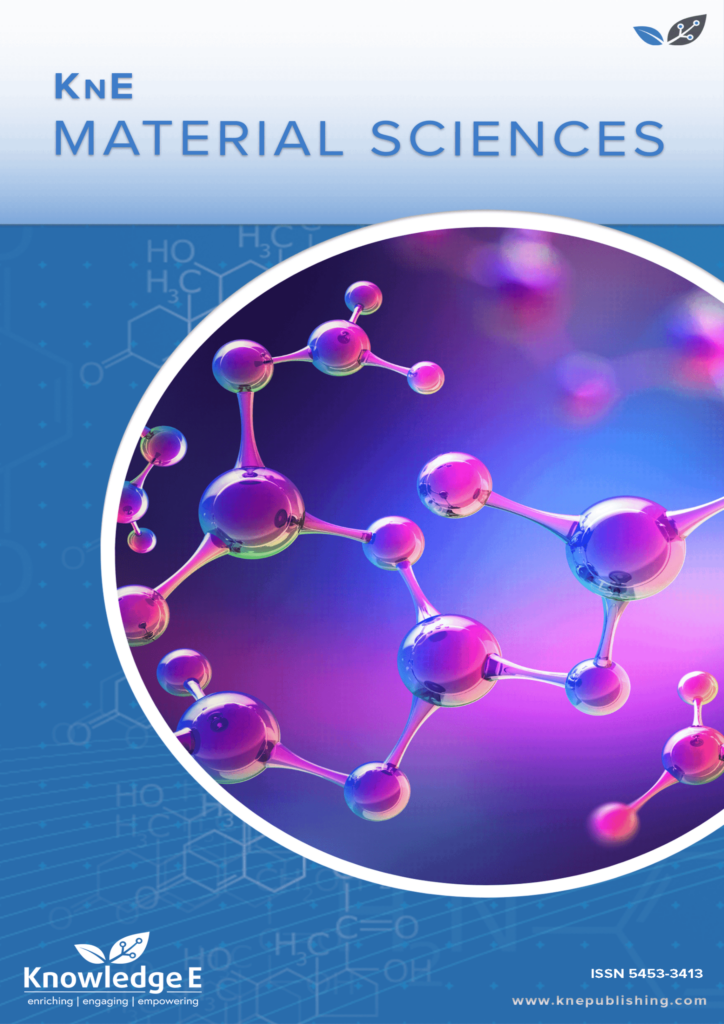
KnE Materials Science
ISSN: 2519-1438
The latest conference proceedings on physical materials, energy materials, electrical materials.
Development of Biodegradable, Cellulose-Based, Essential Oil and Chitosan Drug Delivery Systems for Cosmetic Mask Applications
Published date: Aug 10 2022
Journal Title: KnE Materials Science
Issue title: 1st International FibEnTech Congress (FibEnTech21) – New Opportunities for Fibrous Materials in the Ecological Transition
Pages: 63–71
Authors:
Abstract:
The goal of this research was the development of cellulose-based biodegradable drug delivery systems solutions for cosmetic mask applications. Cellulose-based materials derived from natural renewable sources provide a sustainable alternative to nonwoven cosmetic masks derived from nondegradable fossil-based raw materials. An experimental design was executed to assemble the 3D cellulose fibres matrix and the water in oil emulsion comprising the active molecules from Mentha piperita L. Two types of biopolymeric additives were used, one derived from a nano/micro fibrillated cellulose pulp and another one including chitosan. A 3D computational simulation study was performed to enhance porosity and strength properties. The results indicated that the cosmetic face mask optimized prototypes, made from a biodegradable 3D matrix of cellulose fibres and active molecules, are suitable for dermic use.
Keywords: biopolymers, dermic application, drug delivery systems (DDS), essential oil, Mentha piperita
References:
[1] Lavoine N, Desloges I, Dufresne A, Bras J. Microfibrillated cellulose - Its barrier properties and applications in cellulosic materials: A review. Carbohydrate Polymers. 2012;90(2):735–764. https://doi.org/10.1016/j.carbpol.2012.05.026
[2] Jorfi M, Foster EJ. Recent advances in nanocellulose for biomedical applications. Journal of Applied Polymer Science. 2015;132(14):1–19. https://doi.org/10.1002/app.41719
[3] Abeer MM, Mohd Amin MCI, Martin C. A review of bacterial cellulosebased drug delivery systems: Their biochemistry, current approaches and future prospects. Journal of Pharmacy and Pharmacology. 2014;66(8):1047–1061. https://doi.org/10.1111/jphp.12234
[4] Abitbol T, Rivkin A, Cao Y et al. Nanocellulose, a tiny fiber with huge applications. Current Opinion in Biotechnology. 2016 ;39(I):76–88. https://doi.org/10.1016/j.copbio.2016.01.002
[5] Arias M, López A, Vilaseca M et al. Influence of chitosan characteristics in the microencapsulation of essential oils. Journal of Biomedical Science and Engineering. 2021;14:119-129. https://doi.org/10.4236/jbise.2021.143012
[6] Klimek-Szczykutowicz M, Szopa A, Ekiert H. Citrus limon (lemon) phenomenon — A review of the chemistry, pharmacological properties, applications in the modern pharmaceutical, food, and cosmetics industries, and biotechnological studies. Plants. 2020;9(1). https://doi.org/10.3390/plants9010119
[7] Pavoni L, Perinelli DR, Bonacucina G, Cespi M, Palmieri GF. An overview of micro- and nanoemulsions as vehicles for essential oils: Formulation, preparation and stability. Nanomaterials. 2020;10(1):135. https://doi.org/10.3390/nano10010135
[8] Mutlu-Ingok A, Devecioglu D, Dikmetas DN, Karbancioglu-Guler F, Capanoglu E. Antibacterial, antifungal, antimycotoxigenic, and antioxidant activities of essential oils: An updated review. Molecules. 2020;25(20). https://doi.org/10.3390/molecules25204711
[9] Turek C, Stintzing FC. Stability of essential oils: A review. Comprehensive Reviews in Food Science and Food Safety. 2013;12(1):40–53. https://doi.org/10.1111/1541- 4337.12006
[10] Angioni A, Barra A, Coroneo V, Dessi S, Cabras P. Chemical composition, seasonal variability, and antifungal activity of Lavandula stoechas L. ssp. stoechas essential oils from stem/leaves and flowers. Journal of Agricultural and Food Chemistry. 2006;54(12):4364–4370. https://doi.org/10.1021/jf0603329
[11] Baptista-Silva S, Borges S, Ramos OL, Pintado M, Sarmento B. The progress of essential oils as potential therapeutic agents: A review. Journal of Essential Oil Research. 2020;32(4):279–295. https://doi.org/10.1080/10412905.2020.1746698
[12] Shaaban HAE, El-Ghorab AH, Shibamoto T. Bioactivity of essential oils and their volatile aroma components: Review. Journal of Essential Oil Research. 2012;24(2):203–212. https://doi.org/10.1080/10412905.2012.659528
[13] Morais FM, Simões RMS, Curto JM. Biopolymeric delivery systems for cosmetic applications using Chlorella vulgaris algae and tea tree essential oil. Polymers. 2020;12(11). https://doi.org/10.3390/polym12112689
[14] Morais FP, Carta AMMS, Amaral ME, Curto JMR. Micro/nano-fibrillated cellulose (MFC/NFC) fibers as an additive to maximize eucalyptus fibers on tissue paper production. Cellulose. 2021;28:6587–6605. https://doi.org/10.1007/s10570- 021-03912-9
[15] Morais FP, Carta AMMS, Amaral ME, Curto JMR. Cellulose fiber enzymatic modification to improve the softness, strength, and absorption properties of tissue papers. BioResources. 2021;16:846-861.
[16] Spiridon I, Duarte AP, Curto J. Influence of xilanase treatment on Pinus pinaster kraft pulp. Cellulose Chemistry and Technology. 2003;37(3-4):497-504.
[17] Mota AS, Martins RM, Arantes S et al. Antimicrobial activity and chemical composition of the essential oils of Portuguese Foeniculum vulgare fruits. Natural Product Communications. 2015;10(4):673-676.
[18] Morais FP, Carta AMMS, Amaral ME, Curto JMR. 3D fiber models to simulate and optimize tissue materials. BioResources. 2020;15:8833-8848.
[19] Curto JMR, Conceição ELT, Portugal ATG, Simões RMS. Three-dimensional modelling of fibrous materials and experimental validation. Materialwissenschaft Und Werkstofftechnik. 2011;42(5):370–374. https://doi.org/10.1002/mawe.201100790